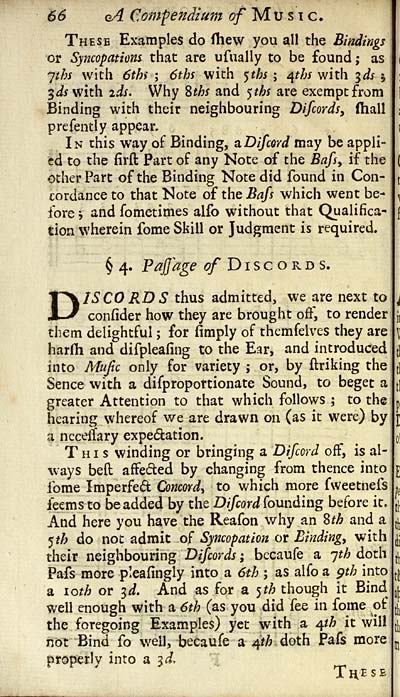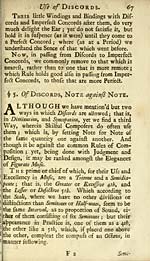Glen Collection of printed music > Printed text > Compendium, or, Introduction to practical music
(88) Page 66
Download files
Complete book:
Individual page:
Thumbnail gallery: Grid view | List view

66 qA Comfe?idium ofMvsic.
These Examples do fhew you all the Bindings
or Syncopations that are ufually to be found ; as
jths with 6thi ; 6ths with <)ths ; ^ths with -^ds %
Sds with ids. Why Sths and $ths are exempt from
Binding with their neighbouring Difcords, (hall
prefently appear.
In this way of Binding, aDifcord may be appli-
ed to the firft Part of any Note of the Bafsy if the
other Part of the Binding Note did found in Con-
cordance to that Note of the Bafs which went be-
fore j and fometimes alfo without that Qualifica-
tion wherein fome Skill or Judgment is required.
§ 4. Fajjage (?/ D i s c o r d s.
DISCORDS thus admitted, we are next to
confider how they are brought off, to render
them delightful ; for fimply of themfelves they are
harfii and difpleafing to the Ear, and introduced
into Mujic only for variety ; or, by ftriking the
Sence with a difpropottionate Sound, to beget a
greater Attention to that which follows ; to the
hearing whereof we are drawn on (as it were) by
a nccelTary expedation.
This winding or bringing a Difcord off, is al-
ways beft affeded by changing from thence into
fome Imperfed Concord^ to which more fweetnefs
feemsto be added by the D//cor^ founding before it.
And here you have the Reafon why an 2th and a
^th do not admit of Syncopation or Binding, with
their neighbouring Difcords ; becaufe a jth doth
Pafs more pleafingly into a 6tb ; as alfo a gth into
a loth or 3^. And as for a ph though it Bind
well enough with a 6th (as you did fee in fome of
the foregoing Examples) yet with a 4//? it will
not Bind fo well, becaufe a 4?/; doth Pafs more
proper! V into a ^d.
These
These Examples do fhew you all the Bindings
or Syncopations that are ufually to be found ; as
jths with 6thi ; 6ths with <)ths ; ^ths with -^ds %
Sds with ids. Why Sths and $ths are exempt from
Binding with their neighbouring Difcords, (hall
prefently appear.
In this way of Binding, aDifcord may be appli-
ed to the firft Part of any Note of the Bafsy if the
other Part of the Binding Note did found in Con-
cordance to that Note of the Bafs which went be-
fore j and fometimes alfo without that Qualifica-
tion wherein fome Skill or Judgment is required.
§ 4. Fajjage (?/ D i s c o r d s.
DISCORDS thus admitted, we are next to
confider how they are brought off, to render
them delightful ; for fimply of themfelves they are
harfii and difpleafing to the Ear, and introduced
into Mujic only for variety ; or, by ftriking the
Sence with a difpropottionate Sound, to beget a
greater Attention to that which follows ; to the
hearing whereof we are drawn on (as it were) by
a nccelTary expedation.
This winding or bringing a Difcord off, is al-
ways beft affeded by changing from thence into
fome Imperfed Concord^ to which more fweetnefs
feemsto be added by the D//cor^ founding before it.
And here you have the Reafon why an 2th and a
^th do not admit of Syncopation or Binding, with
their neighbouring Difcords ; becaufe a jth doth
Pafs more pleafingly into a 6tb ; as alfo a gth into
a loth or 3^. And as for a ph though it Bind
well enough with a 6th (as you did fee in fome of
the foregoing Examples) yet with a 4//? it will
not Bind fo well, becaufe a 4?/; doth Pafs more
proper! V into a ^d.
These
Set display mode to: Large image | Transcription
Images and transcriptions on this page, including medium image downloads, may be used under the Creative Commons Attribution 4.0 International Licence unless otherwise stated. ![]()
| Special collections of printed music > Glen Collection of printed music > Printed text > Compendium, or, Introduction to practical music > (88) Page 66 |
|---|
| Permanent URL | https://digital.nls.uk/87775060 |
|---|
| Description | Scottish songs and music of the 18th and early 19th centuries, including music for the Highland bagpipe. These are selected items from the collection of John Glen (1833 to 1904). Also includes a few manuscripts, some treatises, and other books on the subject. |
|---|
| Description | The Glen Collection and the Inglis Collection represent mainly 18th and 19th century Scottish music, including Scottish songs. The collections of Berlioz and Verdi collected by bibliographer Cecil Hopkinson contain contemporary and later editions of the works of the two composers Berlioz and Verdi. |
|---|

